使用

index.js
import vue from 'vue'
import vuex from 'vuex'
import getters from './getters'
import app from './modules/app'
import settings from './modules/settings'
import user from './modules/user'
import system from './modules/system'
vue.use(vuex)
const store = new vuex.store({
modules: {
app,
settings,
user,
system
},
getters
})
export default storegetters.js
const getters = {
sidebar: state => state.app.sidebar,
device: state => state.app.device,
token: state => state.user.token,
avatar: state => state.user.avatar,
name: state => state.user.name,
currentuserinfo: state => state.system.currentuserinfo,
count: state => state.system.count,
}
export default getterssystem.js
const system = {
namespaced: true,
state: {
currentuserinfo: {},
count: 0,
},
mutations: {
set_currentuserinfo: (state, currentuserinfo) => {
state.currentuserinfo = currentuserinfo
},
set_count: (state, count) => {
state.count = count
},
}
}
export default system全局使用:main.js文件中
import store from './store'
new vue({
el: '#app',
router,
store,
render: h => h(app)
})vuex概述
vuex是实现组件全局状态(数据)管理的一种机制,可以方便的实现组件之间的数据共享
使用vuex管理数据的好处:
a.能够在vuex中集中管理共享的数据,便于开发和后期进行维护
b.能够高效的实现组件之间的数据共享,提高开发效率
c.存储在vuex中的数据是响应式的,当数据发生改变时,页面中的数据也会同步更新
vuex中的核心特性
vuex中的主要核心概念如下:
- state
- mutation
- action
- getter
a.state
state提供唯一的公共数据源,所有共享的数据都要统一放到store中的state中存储 例如,打开项目中的store.js文件,在state对象中可以添加我们要共享的数据,如:count:0

在组件中访问state的方式:
1).this.$store.state.全局数据名称 如:this.$store.state.count
2).先按需导入mapstate函数: import { mapstate } from 'vuex'
然后数据映射为计算属性: computed:{ ...mapstate(['全局数据名称']) }this.$store.state.全局数据名称-组件访问state中的数据的第一种方式
//访问
console.log("1111",this.$store.state.system.count);
<h3>当前最新的count值为:{{$store.state.system.count}}</h3>组件访问state中的数据的第二种方式:按需导入
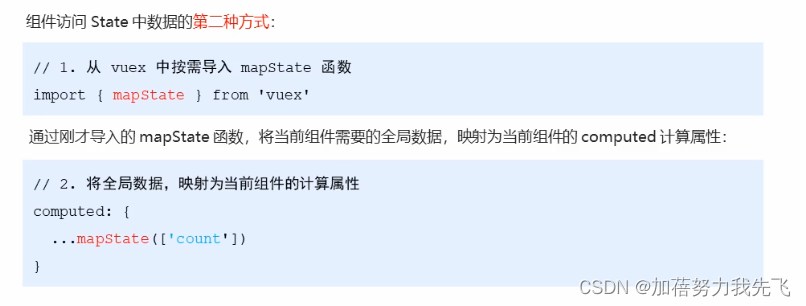
2).先按需导入mapstate函数: import { mapstate } from 'vuex'
//将全局数据,用展开运算符映射为当前组件的计算属性
// 然后数据映射为计算属性: computed:{ ...mapstate(['count']) }
mapstate()可以传入对象或者数组
传入数组用法: mapstate(['counte', 'name','age'])
// 传入对象用法:可以重命名store中的数据
...mapstate({
scounter: state => state.name,
......
})
computed:{
...mapstate({
count: state => state.system.count,
......
}),
}b.mutation
mutation用于修改变更$store中的数据
只能通过mutation变更store数据,不可以直接操作store中的数据通过这种方式虽然操作起来稍微繁琐点,但是可以集中监控所有的数据变化
this.$store.commit是触发mutation的第一种方式
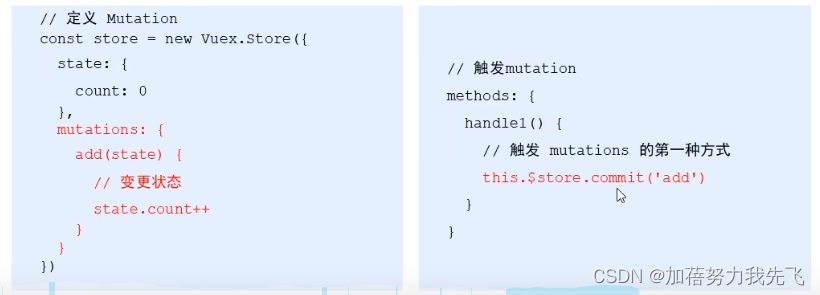
1.定义:
const system = {
namespaced: true,
state: {
count: 0,
},
mutations: {
add(state) {
//变更状态
state.count++
}
}
}
export default system2.使用
<template>
<div>
<h3>当前最新的count值为:{{$store.state.system.count}}</h3>
<el-button type="primary" @click="btnhandler1">+1</el-button>
</div>
</template>
<script>
export default {
name: 'addition',
props: {
},
data() {
return {
}
},
computed: {},
mounted() {},
methods: {
btnhandler1() {
this.$store.commit("system/add")
},
}
}
</script>
<style scoped>
</style>1.传参—定义
mutations: {
add(state) {
state.count++
},
addn(state, step) {
state.count += step
}
}2.传参-使用
methods: {
btnhandler1() {
this.$store.commit("system/add")
},
btnhandler2(val){
// commit 的作用就是调用某个mutation函数
this.$store.commit("system/addn",val)
},
}触发mutation的第二种方式,按需导入
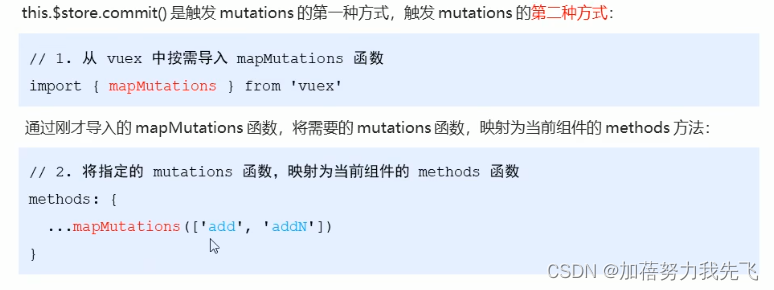
从vuex中按需导入mapmutations 函数
import { mapmutations } from 'vuex'通过刚才导入的mapmutations 函数,将需要的mapmutations 函数,映射为当前组件的methods方法:
sub(state) {
state.count--
},
subn(state, step) {
state.count -= step
},method:{
...mapmutations({
sub: 'system/sub'
}),
btnhandler1(){
this.sub()//直接引用
},
btnhandler2(val){
this.subn(val)
},
}c.action
action用于处理异步任务
如果通过异步操作变更数据,必须通过action,而不能使用mutation,但action中还是要通过出发mutation的方式间接变更数据

this.$store.dispatch()是触发actions的第一种方式
actions: {
addasync(content) {
settimeout(() => {
// 在actions中,不能直接修改state中的数据
// 必须通过content.commit() 去触发某个mutations才行
content.commit('add')
}, 1000)
}
}methods: {
// 异步的让count自增+1
btnhandler3(){
// 这里的dispatch函数,专门用来触发actions
this.$store.dispatch('system/addasync')
},
}actions携带参数
触发actions异步任务时携带参数
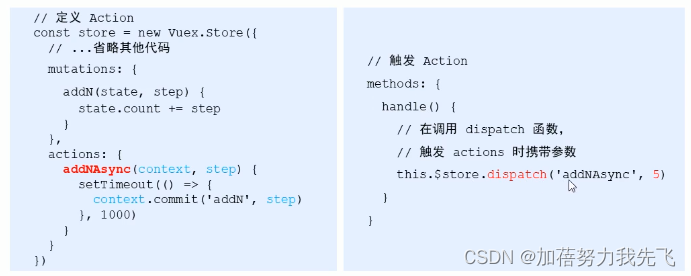
actions: {
addnasync(content, step) {
settimeout(() => {
// 在actions中,不能直接修改state中的数据
// 必须通过content.commit() 去触发某个mutations才行
content.commit('addn', step)
}, 1000)
},
}methods: {
btnhandler4(){
// 这里的dispatch函数,专门用来触发actions,传参
this.$store.dispatch('system/addnasync',3)
},
}触发actions的第二种方式:按需导入

actions: {
subasync(content) {
settimeout(() => {
// 在actions中,不能直接修改state中的数据
// 必须通过content.commit() 去触发某个mutations才行
content.commit('sub')
}, 1000)
},
subnasync(content, step) {
settimeout(() => {
// 在actions中,不能直接修改state中的数据
// 必须通过content.commit() 去触发某个mutations才行
content.commit('subn', step)
}, 1000)
},
}import {mapactions } from 'vuex'
methods:{
...mapactions({
subasync: 'system/subasync',
subnasync: 'system/subnasync',
}),
btnhandler3(){
this.subasync()
},
btnhandler4(){
this.subnasync(3)
},
}d.getter
getter用于对store中的数据进行加工处理形成新的数据
它只会包装store中保存的数据,并不会修改store中保存的数据,当store中的数据发生变化时,getter生成的内容也会随之变化
打开store.js文件,添加getters,如下:

使用getters的第一种方式
//system.js文件中的 getters中的shownum
<h3>{{$store.getters['system/shownum']}}</h3>
console.log('$store.state',this.$store.getters['system/shownum']);使用getters的第二种方式
<h3>{{shownum}}</h3> computed: {
...mapgetters({
shownum: 'system/shownum',
})
},代码总结
system.js
const system = {
namespaced: true,
state: {
currentuserinfo: {},
count: 0,
},
// 只有mutations中定义的函数,才有全力修改state中的数据
mutations: {
// set_currentuserinfo: (state, currentuserinfo) => {
// state.currentuserinfo = currentuserinfo
// },
// set_count: (state, count) => {
// state.count = count
// },
add(state) {
state.count++
},
addn(state, step) {
state.count += step
},
sub(state) {
state.count--
},
subn(state, step) {
state.count -= step
},
},
actions: {
addasync(content) {
settimeout(() => {
// 在actions中,不能直接修改state中的数据
// 必须通过content.commit() 去触发某个mutations才行
content.commit('add')
}, 1000)
},
addnasync(content, step) {
settimeout(() => {
// 在actions中,不能直接修改state中的数据
// 必须通过content.commit() 去触发某个mutations才行
content.commit('addn', step)
}, 1000)
},
subasync(content) {
settimeout(() => {
// 在actions中,不能直接修改state中的数据
// 必须通过content.commit() 去触发某个mutations才行
content.commit('sub')
}, 1000)
},
subnasync(content, step) {
settimeout(() => {
// 在actions中,不能直接修改state中的数据
// 必须通过content.commit() 去触发某个mutations才行
content.commit('subn', step)
}, 1000)
},
},
getters: {
//添加了一个shownum的属性
shownum(state) {
return '最新的count值为:【' + state.count + '】';
}
}
}
export default systemsrc\views\learnvuex\index.vue
<template>
<div>
<my-addition ></my-addition>
<p>----------------------</p>
<my-subtranction ></my-subtranction>
</div>
</template>
<script>
// 导入
import addition from '@/components/addition';
import subtranction from '@/components/subtranction';
// import subtranction from '../../components/addition';
export default {
name: 'learnvuex',
props: {},
// 注册
components: {
'my-addition': addition,
'my-subtranction': subtranction
},
data() {
return {
}
},
computed: {},
mounted(){
console.log("1111",this.$store.state.system.count);
},
}
</script>
<style scoped>
</style>src\components\addition\index.vue
<template>
<div>
<h3>当前最新的count值为:{{$store.state.system.count}}</h3>
<h3>{{$store.getters['system/shownum']}}</h3>
<el-button type="primary" @click="btnhandler1">+1</el-button>
<el-button type="primary" @click="btnhandler2(2)">+2</el-button>
<el-button type="primary" @click="btnhandler2(3)">+3</el-button>
<el-button type="primary" @click="btnhandler3">+1 async</el-button>
<el-button type="primary" @click="btnhandler4">+3 async</el-button>
</div>
</template>
<script>
export default {
name: 'addition',
props: {
},
data() {
return {
}
},
computed: {},
mounted() {
console.log('$store.state',this.$store.getters['system/shownum']);
},
methods: {
btnhandler1() {
this.$store.commit("system/add")
},
btnhandler2(val){
// commit 的作用就是调用某个mutation函数
this.$store.commit("system/addn",val)
},
// 异步的让count自增+1
btnhandler3(){
// 这里的dispatch函数,专门用来触发actions
this.$store.dispatch('system/addasync')
},
//
btnhandler4(){
// 这里的dispatch函数,专门用来触发actions
this.$store.dispatch('system/addnasync',3)
},
}
}
</script>
<style scoped>
</style>\src\components\subtranction\index.vue
<template>
<div>
<h3>当前最新的count值为:{{count}}</h3>
<h3>{{shownum}}</h3>
<el-button type="primary" @click="btnhandler1">-1</el-button>
<el-button type="primary" @click="btnhandler2(2)">-2</el-button>
<el-button type="primary" @click="btnhandler2(3)">-3</el-button>
<el-button type="primary" @click="btnhandler3">-1 async</el-button>
<el-button type="primary" @click="btnhandler4">-3 async</el-button>
</div>
</template>
<script>
import { mapstate,mapmutations,mapactions,mapgetters } from 'vuex'
export default {
name: 'subtranction',
props: {},
data(){
return{
}
},
computed: {
...mapstate({
count: state => state.system.count,
}),
...mapgetters({
shownum: 'system/shownum',
})
},
mounted(){
console.log("mapstate",this.count);
},
methods:{
...mapmutations({
sub: 'system/sub',
subn: 'system/subn',
}),
...mapactions({
subasync: 'system/subasync',
subnasync: 'system/subnasync',
}),
btnhandler1(){
this.sub()
},
btnhandler2(val){
this.subn(val)
},
btnhandler3(){
this.subasync()
},
btnhandler4(){
this.subnasync(3)
},
}
}
</script>
<style scoped>
</style>以上就是vue全家桶-vuex深入讲解的详细内容,更多关于vue全家桶-vuex的资料请关注代码网其它相关文章!

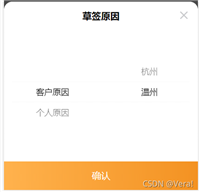




发表评论